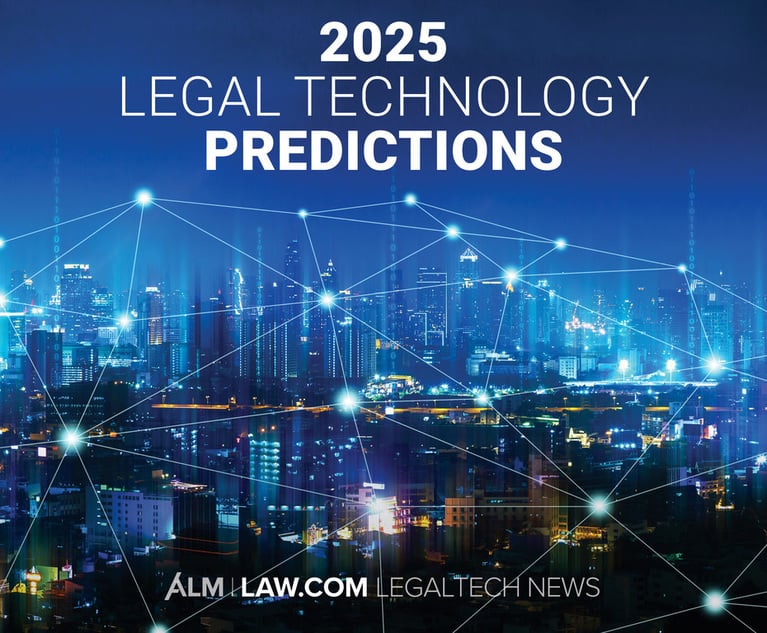Four certainties about alternative fee arrangements
There are those who say AFAs are redefining the industry and those who say theyve heard that for the better part of decade, but the truth may be in the middle.
November 25, 2013 at 03:00 AM
7 minute read
The original version of this story was published on Law.com
Industry viewpoints on alternative fee arrangements (AFAs) tend to fall into two camps. There are those who say AFAs are redefining the industry and those who say they've heard that for the better part of decade.
According to the latter, it hasn't happened. Not yet.
The truth, however, usually falls somewhere in the middle. Analytics can provide general counsel with more credibility, and can also be used to slice up “big data” to give them more detail on AFAs. The data consistently leads me to conclude that while the future of AFAs is uncertain, there are four certainties related to AFAs.
1. Economics drive AFAs. Businesses are focused on the bottom line and have two main requirements from all cost centers: a) reduce or at least hold the line on costs, and b) provide budgeting predictability. For a time, the general counsel could raise the “risk” flag and the corporation would provide a blank check. Those days are over. Corporate legal departments are increasingly required to rationalize their expenses and demonstrate value to their organizations. AFAs help general counsel prove that value in terms of cost management, expense predictability and, also, by building stronger partnerships and relationships with their outside counsel.
2. Blended rates are not AFAs. Blended rate arrangements occur when a senior partner and a first year associate bill at the same rate, regardless of their experience. This is not an AFA, but rather a discount of the billable hour and an ineffective way to help general counsel manage costs. Blended rate arrangements make no effort to control a critical variable — billable hours. An Alternative Fee Arrangement, by definition, is an alternative to billable hour-based fees where both parties share some risk in moving away from the billable hour paradigm. A standard definition is important if, as an industry, we desire to measure and evaluate our process improvement.
3. Data can inform legal pricing and packaging. The key to properly structuring legal fees includes taking an historical analysis of data about the type of work performed, the staffing requirements needed and the time it took to complete it. We see this happening regularly in repetitious work, such as in insurance, but it can also be applied for more complex work such as litigation by breaking those matters down into phases. There is a plethora of data that can be analyzed in the billing systems of law firms and the enterprise legal management systems of legal departments that will help develop a baseline for beginning to structure agreements.
4. AFAs as a law firm competitive advantage. Some industry watchers suggest AFAs are simply a vehicle for the general counsel to drive a hard bargain with law firms. The reality, however, is about driving efficiency — and efficiency presents the opportunity for firms to grow more business. In the eyes of the corporate law department, outside counsel raises the question of value rather than price. For law firms, it's an opportunity to strengthen a relationship with a client and, perhaps. to win a greater share of work in the process.
So the question remains: Are AFAs redefining the industry? From my vantage point, which considers economics as the motivation, AFAs provide an opportunity for law firms and their corporate legal clients to collaborate and move the legal profession forward. Discussions should be centered on how to best structure and price legal work to the advantage of all parties instead of one side benefitting over the other. Data and analytics can be used to inform productive discussions around AFAs. Admittedly, AFAs may not come entirely free of risk, but as history proves time and again, great rewards can't be reaped without a willingness to shoulder some risk.
Industry viewpoints on alternative fee arrangements (AFAs) tend to fall into two camps. There are those who say AFAs are redefining the industry and those who say they've heard that for the better part of decade.
According to the latter, it hasn't happened. Not yet.
The truth, however, usually falls somewhere in the middle. Analytics can provide general counsel with more credibility, and can also be used to slice up “big data” to give them more detail on AFAs. The data consistently leads me to conclude that while the future of AFAs is uncertain, there are four certainties related to AFAs.
1. Economics drive AFAs. Businesses are focused on the bottom line and have two main requirements from all cost centers: a) reduce or at least hold the line on costs, and b) provide budgeting predictability. For a time, the general counsel could raise the “risk” flag and the corporation would provide a blank check. Those days are over. Corporate legal departments are increasingly required to rationalize their expenses and demonstrate value to their organizations. AFAs help general counsel prove that value in terms of cost management, expense predictability and, also, by building stronger partnerships and relationships with their outside counsel.
2. Blended rates are not AFAs. Blended rate arrangements occur when a senior partner and a first year associate bill at the same rate, regardless of their experience. This is not an AFA, but rather a discount of the billable hour and an ineffective way to help general counsel manage costs. Blended rate arrangements make no effort to control a critical variable — billable hours. An Alternative Fee Arrangement, by definition, is an alternative to billable hour-based fees where both parties share some risk in moving away from the billable hour paradigm. A standard definition is important if, as an industry, we desire to measure and evaluate our process improvement.
3. Data can inform legal pricing and packaging. The key to properly structuring legal fees includes taking an historical analysis of data about the type of work performed, the staffing requirements needed and the time it took to complete it. We see this happening regularly in repetitious work, such as in insurance, but it can also be applied for more complex work such as litigation by breaking those matters down into phases. There is a plethora of data that can be analyzed in the billing systems of law firms and the enterprise legal management systems of legal departments that will help develop a baseline for beginning to structure agreements.
4. AFAs as a law firm competitive advantage. Some industry watchers suggest AFAs are simply a vehicle for the general counsel to drive a hard bargain with law firms. The reality, however, is about driving efficiency — and efficiency presents the opportunity for firms to grow more business. In the eyes of the corporate law department, outside counsel raises the question of value rather than price. For law firms, it's an opportunity to strengthen a relationship with a client and, perhaps. to win a greater share of work in the process.
So the question remains: Are AFAs redefining the industry? From my vantage point, which considers economics as the motivation, AFAs provide an opportunity for law firms and their corporate legal clients to collaborate and move the legal profession forward. Discussions should be centered on how to best structure and price legal work to the advantage of all parties instead of one side benefitting over the other. Data and analytics can be used to inform productive discussions around AFAs. Admittedly, AFAs may not come entirely free of risk, but as history proves time and again, great rewards can't be reaped without a willingness to shoulder some risk.
This content has been archived. It is available through our partners, LexisNexis® and Bloomberg Law.
To view this content, please continue to their sites.
Not a Lexis Subscriber?
Subscribe Now
Not a Bloomberg Law Subscriber?
Subscribe Now
NOT FOR REPRINT
© 2025 ALM Global, LLC, All Rights Reserved. Request academic re-use from www.copyright.com. All other uses, submit a request to [email protected]. For more information visit Asset & Logo Licensing.
You Might Like
View All


From Reluctant Lawyer to Legal Trailblazer: Agiloft's GC on Redefining In-House Counsel With Innovation and Tech
7 minute read
Legal Tech's Predictions for Legal Ops & In-House in 2025
Trending Stories
- 1Varsity Brands Lures Aboard Keurig Dr. Pepper Legal Chief
- 2Federal Judge Warns of 'Serious Sanctions' on FDIC Over Document Retention
- 3Meet the Former NFL Player Now Back at Vinson & Elkins
- 4Inside Track: Cooley's Modest Proposal to Make Executives Safer
- 5Justified Termination Does Not Bar Associate Attorney From Unemployment Benefits, State Appellate Court Rules
Who Got The Work
J. Brugh Lower of Gibbons has entered an appearance for industrial equipment supplier Devco Corporation in a pending trademark infringement lawsuit. The suit, accusing the defendant of selling knock-off Graco products, was filed Dec. 18 in New Jersey District Court by Rivkin Radler on behalf of Graco Inc. and Graco Minnesota. The case, assigned to U.S. District Judge Zahid N. Quraishi, is 3:24-cv-11294, Graco Inc. et al v. Devco Corporation.
Who Got The Work
Rebecca Maller-Stein and Kent A. Yalowitz of Arnold & Porter Kaye Scholer have entered their appearances for Hanaco Venture Capital and its executives, Lior Prosor and David Frankel, in a pending securities lawsuit. The action, filed on Dec. 24 in New York Southern District Court by Zell, Aron & Co. on behalf of Goldeneye Advisors, accuses the defendants of negligently and fraudulently managing the plaintiff's $1 million investment. The case, assigned to U.S. District Judge Vernon S. Broderick, is 1:24-cv-09918, Goldeneye Advisors, LLC v. Hanaco Venture Capital, Ltd. et al.
Who Got The Work
Attorneys from A&O Shearman has stepped in as defense counsel for Toronto-Dominion Bank and other defendants in a pending securities class action. The suit, filed Dec. 11 in New York Southern District Court by Bleichmar Fonti & Auld, accuses the defendants of concealing the bank's 'pervasive' deficiencies in regards to its compliance with the Bank Secrecy Act and the quality of its anti-money laundering controls. The case, assigned to U.S. District Judge Arun Subramanian, is 1:24-cv-09445, Gonzalez v. The Toronto-Dominion Bank et al.
Who Got The Work
Crown Castle International, a Pennsylvania company providing shared communications infrastructure, has turned to Luke D. Wolf of Gordon Rees Scully Mansukhani to fend off a pending breach-of-contract lawsuit. The court action, filed Nov. 25 in Michigan Eastern District Court by Hooper Hathaway PC on behalf of The Town Residences LLC, accuses Crown Castle of failing to transfer approximately $30,000 in utility payments from T-Mobile in breach of a roof-top lease and assignment agreement. The case, assigned to U.S. District Judge Susan K. Declercq, is 2:24-cv-13131, The Town Residences LLC v. T-Mobile US, Inc. et al.
Who Got The Work
Wilfred P. Coronato and Daniel M. Schwartz of McCarter & English have stepped in as defense counsel to Electrolux Home Products Inc. in a pending product liability lawsuit. The court action, filed Nov. 26 in New York Eastern District Court by Poulos Lopiccolo PC and Nagel Rice LLP on behalf of David Stern, alleges that the defendant's refrigerators’ drawers and shelving repeatedly break and fall apart within months after purchase. The case, assigned to U.S. District Judge Joan M. Azrack, is 2:24-cv-08204, Stern v. Electrolux Home Products, Inc.
Featured Firms
Law Offices of Gary Martin Hays & Associates, P.C.
(470) 294-1674
Law Offices of Mark E. Salomone
(857) 444-6468
Smith & Hassler
(713) 739-1250






